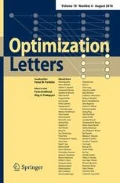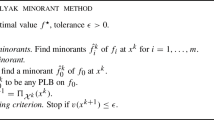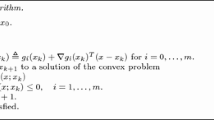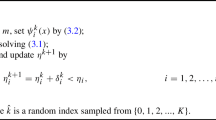Abstract
In the study of interior-point methods for nonsymmetric conic optimization and their applications, Nesterov (Optim Methods Softw 27(4–5): 893–917, 2012) introduced a 4-self-concordant barrier for the power cone, also known as Koecher’s cone. In his PhD thesis, Chares (Cones and interior-point algorithms for structured convex optimization involving powers and exponentials, PhD thesis, Universite catholique de Louvain, 2009) found an improved 3-self-concordant barrier for the power cone. In addition, he introduced the generalized power cone, and conjectured a “nearly optimal” self-concordant barrier for it. In this paper, we prove Chares’ conjecture. As a byproduct of our analysis, we derive a self-concordant barrier for a nonnegative power cone.

Similar content being viewed by others
References
Badenbroek, R., Dahl, J.: An algorithm for nonsymmetric conic optimization inspired by MOSEK. Preprint. arXiv:2003.01546 (2020)
Ben-Tal, A., Nemirovski, A.: Lectures on Modern Convex Optimization: Analysis, Algorithms, and Engineering Applications. SIAM, MPS-SIAM Series on Optimization (2001)
Chares, P.R.: Cones and interior-point algorithms for structured convex optimization involving powers and exponentials. PhD thesis, Universite catholique de Louvain (2009)
Dahl, J., Andersen, E.D.: A primal–dual interior-point algorithm for nonsymmetric exponential-cone optimization. Preprint, MOSEK white paper (2019)
Güler, O.: Barrier functions in interior point methods. Math. Oper. Res. 21(4), 860–885 (1996)
Hildebrand, R.: A lower bound on the barrier parameter of barriers for convex cones. Math. Program. 142(1), 311–329 (2013)
Koecher, M.: Positivitätsbereiche in \({R}^n\). Am. J. Math. 79(3), 575–596 (1957)
Nesterov, Y.: Constructing self-concordant barriers for convex cones. CORE discussion paper 2006/30, Center for Operations Research and Econometrics, Catholic University of Louvain (2006)
Nesterov, Y.: Primal–dual interior-point methods with asymmetric barriers. CORE discussion paper 2008/57, Center for Operations Research and Econometrics, Catholic University of Louvain (2008)
Nesterov, Y.: Towards non-symmetric conic optimization. Optim. Methods Softw. 27(4–5), 893–917 (2012)
Nesterov, Y., Nemirovskii, A. Interior-point polynomial algorithms in convex programming, volume 13 of SIAM Studies in Applied Mathematics. Society for Industrial and Applied Mathematics (SIAM), Philadelphia, PA (1994)
Serrano, S.A.: Algorithms for unsymmetric cone optimization and implementation for problems with the exponential cone. PhD thesis, Standford University (2015)
Skajaa, A., Ye, Y.: A homogeneous interior-point algorithm for nonsymmetric convex conic optimization. Math. Program. 150(2), 391–422 (2015)
Truong, V.A., Tunçel, L.: Geometry of homogeneous convex cones, duality mapping, and optimal self-concordant barriers. Math. Program. Ser. A 100, 295–316 (2004)
Tunçel, L.: Generalization of primal–dual interior-point methods to convex optimization problems in conic form. Found. Comput. Math. 1, 229–254 (2001)
Tunçel, L., Nemirovski, A.: Self-concordant barriers for convex approximations of structured convex sets. Found. Comput. Math. 10(5), 485–525 (2010)
Tunçel, L., Song, X.: On homogeneous convex cones, the Carathéodory number, and the duality mapping. Math. Oper. Res. 26(2), 234–247 (2001)
Author information
Authors and Affiliations
Corresponding author
Additional information
Publisher's Note
Springer Nature remains neutral with regard to jurisdictional claims in published maps and institutional affiliations.
Appendix: Derivative calculations
Appendix: Derivative calculations
In this section, we work through the derivative calculations in the proofs of Theorems 1 and 2. All derivatives are taken at the point (x, z) and in direction \((\varDelta x, \varDelta z)\). The first two derivatives of \(\xi \) are easy to compute as \(\xi ' = e_1 \xi \) and \(\xi '' = -e_2 \xi \). Before computing \(\xi '''\), we compute \(e_1'\) and \(e_2'\), which are useful quantities in computing \(\xi '''\) as well as other derivatives later. Noting that \(\delta _i' = -\delta _i^2\) (where \(\delta _i\) is as in the proofs of Theorems 1 and 2), it is straightforward to show
and
We then compute \(\xi '''\) by
Now we compute the derivatives of the function \(f = \xi - \frac{\Vert z\Vert _2^2}{\xi }\) in the proof of Theorem 1:
The derivatives of \(z - \frac{z^2}{\xi }\) in the proof of Theorem 2 are computed in a very similar manner and are omitted.
Rights and permissions
About this article
Cite this article
Roy, S., Xiao, L. On self-concordant barriers for generalized power cones. Optim Lett 16, 681–694 (2022). https://doi.org/10.1007/s11590-021-01748-7
Received:
Accepted:
Published:
Issue Date:
DOI: https://doi.org/10.1007/s11590-021-01748-7




